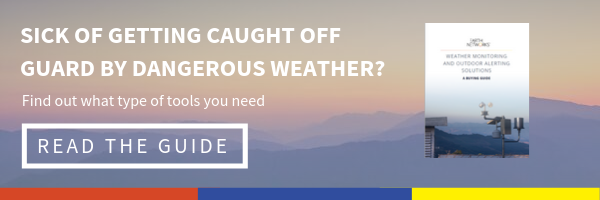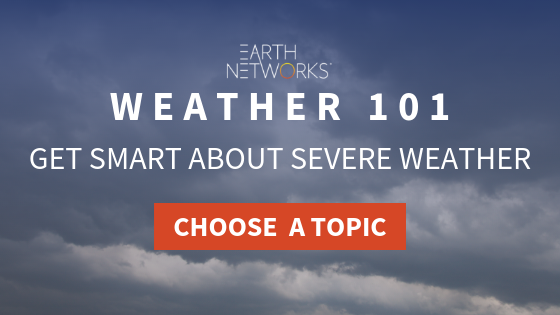What Are Surface Weather Observations?
- Sep 13, 2019

Surface weather observations are an important aspect of meteorology. That’s because they are the basis for all weather safety messages, weather forecasts, and weather warnings worldwide.
But what data counts as surface weather observations, and who uses these observations? Keep reading to find out the basics on weather observations, what they are, and how they impact your daily life.
Types of Weather Observation
Surface weather observations include several elements. In this section, we’ll go over weather observation data typically reported in surface weather observations.
Temperature
![]()
The first surface weather observation most people remember is temperature. You may think of temperature as how hot or cool it feels, but there is much more to it than that.
Temperature is a measure of kinetic energy of a sample of matter. Temperature is the unique physical property that determines the direction of heat flow between two objects placed in thermal contact. If no heat flow occurs, the two objects have the same temperature; otherwise, heat flows from the hotter object to the colder object.
In meteorology, we measure temperature with thermometers exposed to the air but sheltered from direct solar exposure. Most of the world uses the degree Celsius scale, but here in the U.S. we use the degree Fahrenheit temperature scale. Despite this, METAR reports from the United States also report the temperature in degrees Celsius.
Dew Point
![]() Next up is dew point. Dew point, or saturation point, is the temperature a parcel of air cools to for water vapor to condense into water.
Next up is dew point. Dew point, or saturation point, is the temperature a parcel of air cools to for water vapor to condense into water.
When the dew point temperature falls below freezing, we call it the frost point. This is the temperature where water vapor turns into frost rather than dew.
We associate dew point with relative humidity because a high relative humidity shows the dew point is closer to the current air temperature. If the relative humidity is 100%, the dew point is then equal to the current temperatures. Make sense? Humidity is one factor that helps determine wet bulb globe temperature.
Dew point is an important surface weather observation for general aviation pilots, as they use it to help calculate the likelihood of carburetor icing and fog.
Wind
![]() Wind is yet another weather observation. When we refer to wind as a surface weather observation, there are two data points: Wind speed and wind direction.
Wind is yet another weather observation. When we refer to wind as a surface weather observation, there are two data points: Wind speed and wind direction.
We use anemometers and wind vanes, located a standard of 10 meters (33 feet) above ground level, to measure wind speed and wind direction.
When we measure wind direction, we use degrees. North represents 0 or 360 degrees, with values increasing from 0 clockwise to north.
We also measure wind gusts. Wind gust reports generate when there is a variation of the wind speed of over 10 knots (5.1 m/s) between peaks and lulls during the sampling period.
Wind speed and wind direction are two of the real-time surface weather observations we display on our weather map.
Precipitation Amount & Precipitation Intensity
![]() Other important surface weather observations are precipitation amount and intensity. You may hear us refer to these as rainfall amount and rainfall rates.
Other important surface weather observations are precipitation amount and intensity. You may hear us refer to these as rainfall amount and rainfall rates.
Precipitation amount over the past 1, 3, 6, or 24 hours helps meteorologists verify forecasts and determine station climatologies.
Precipitation intensity is how fast precipitation is falling. For example, 1 inch per hour. This helps meteorologists forecast flash flood warnings.
Visibility
One last surface weather observation we’ll cover in depth here is visibility. In the United States, we report visibility in statute miles. However, the worldwide standard is measuring visibility in meters.
Pilots specifically use runway visibility, measured in meters in most locations worldwide except in the United States where we use feet.
Other Weather Observations

This is not an extensive list of surface weather observations, but a list of the most commonly used ones. Some other data included in some observation reports include:
- Station Identifier
- Sea Level Pressure
- Altimeter Setting
- Present Weather
- Snowfall Amount
- Snow Depth
How Surface Weather Observations are Used
These weather observations are a standard and used by everyone from meteorologists, to pilots, to backyard weather station owners.
Meteorological operations use surface weather observations to create surface weather maps. What is a surface weather map? You can check out an example of one from the National Weather Service.

Meteorologists use these maps to get an overview of the current weather situation. This data helps meteorologists locate fronts and storm systems.
One of the first things most Meteorology students learn to do in college is to read observation reports (METARs). Then they learn to plot and analyze them on a weather map.
METARs are the most common format in the world for the transmission of observational weather data.
Besides meteorologists, there are other professionals who use METARs in their line of work. Pilots use surface weather observation data to conduct their pre-flight weather briefings. METARs are very important in the aviation industry.
Weather Forecast Websites and Weather Observations
Weather forecast websites typically use weather observations to help everyday people understand the weather and any current threats.
When using free weather forecast websites and weather applications, it’s important to keep the source of the data in mind. A lot of free providers of weather forecasts get their observations from the nearest airport. While this is great for pilots, it presents problems to everyone who isn’t located near the airport.

The weather can vary a lot, even in the same zip code. That’s why the best practice for organizations making critical weather-related decisions is to use hyperlocal weather data. You want to use commercial-grade surface weather observations so they are as accurate as possible. Timing is also important. Instead of updates every hour, you’ll want weather stations that send information in real time.
Weather Observations: The Backbone for all Weather Forecasts

Our hyperlocal weather network uses surface weather observations to present an accurate look at the basic current weather situation. Once we have these observations, we can make weather maps. But the reach of surface weather observations extends much farther than that.
Surface weather observations the starting point for all weather forecasts. Without surface weather observations and accompanying maps, meteorologists, pilots, and mariners wouldn’t be able to see important weather patterns.
With these real-time observations, we can power our life-saving weather alerts and advise clients on the best course of action. By pairing our advanced alerting technology with weather observations, we help businesses and organizations all over the world mitigate financial, operational, and human weather-related risks.
Learn More About Weather
You don’t have to be a meteorologist to learn more about the weather. That’s why we’ve compiled an easy-to-understand weather glossary on our website.
Weather 101 has information on conditions from hurricanes to hail, technologies like lightning detection, and critical safety information. Head over to 101 to continue building your weather knowledge base. The more you know about weather and severe weather safety, the better you’ll be able to protect the things that matter to you most!
Have any questions we haven’t answered about surface weather observations? Ask them in the comments section below or reach out to us on social media!
#WeatherObservation Question: Share on X





